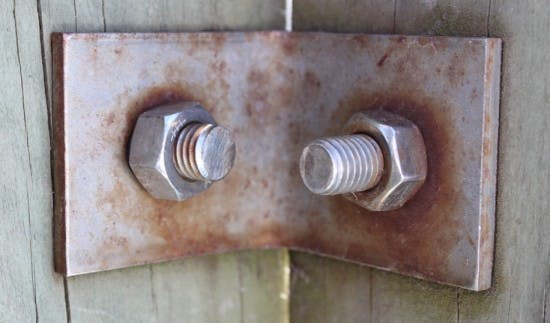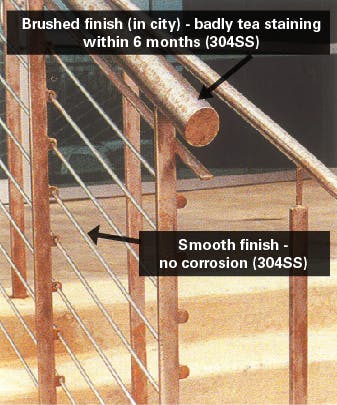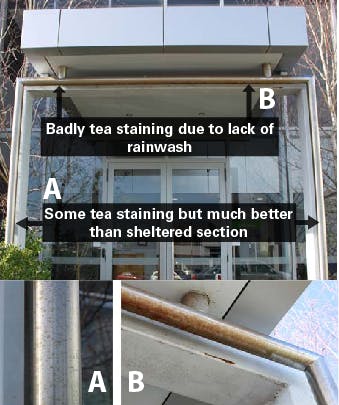
To help you avoid the common mistakes made when specifying and using stainless fasteners, we have put together a short Do's and Dont's guide.
There are many different grades of stainless steel. The two commonly used grades are 304 and 316, with 316 being more corrosion resistant than 304. The rule of thumb is that if the fastener is in a corrosive environment (e.g. within 5km of the coast), 316 is preferable, particularly if the fastener is to be seen, as 316 is less likely to 'tea-stain' or develop a brown discolouration (see photo of bracket showing tea-staining). The Nickel Institute have provided a great design guideline for the selection and use of Stainless Steel to help with this.

10 metres from the beach. Bracket is 304 and showing signs of rust. 316 nuts/bolts are performing well.
In addition to 304 or 316, there are other grades specifically suited to different applications. Please see our guide to selecting the correct grade of stainless steel for your fastener at "Which stainless is right for me?"
Top stainless fastener engineers recommend that all stainless steel threads should be lubricated before being assembled, to reduce the risk of galling (this is when threads lock up). We have found the most risk of galling is with larger threads (M16 upwards), and also when using nyloc nuts. We suggest Lanotec or Nickel Anti-Seize lubricants such as Tef Gel.

The smoother or more polished the finish, the better the corrosion resistance. Some stainless products have a brushed, satin or 'rougher' finish - e.g. sometimes on hinges, fittings, down pipes. This type of finish can trap minute particles (e.g. salt) which damage the protective chromium oxide layer on the stainless steel, causing 'tea-staining', and therefore giving a rusty appearance. This is made worse if the stainless steel is not exposed to rainwater to wash off the particles (see #5 and #6 below).
Electro-polishing or passivating (forms of acid treatment) improves corrosion resistance by thickening the naturally occurring protective chromium oxide layer that forms on stainless steel. All stainless fasteners supplied by Anzor are passivated and can also be electro-polished upon request.
Stainless steel products 'on show' need to be cleaned to remove contaminants (e.g. salt) and therefore maintain the stainless steels appearance. For more information, please see our Cleaning Guidelines.
Stainless steel resists corrosion due to its naturally occurring protective layer ('Chromium Oxide'). When contaminants settle on stainless steel, depending on the grade and the surface finish, these can damage this protective layer, allowing oxygen to react with the iron.
In the stainless steel causing it to rust. If the stainless steel is exposed to rainwater, then this should wash these contaminants away, restoring the stainless steel's protective layer.
Therefore if stainless steel is going to be sheltered from the rain, and it is in a corrosive environment, then consider options to enhance the corrosion resistance: select a more corrosion resistant grade; a smooth/polished/mirror finish; and electro-polishing.
Also consider a cleaning schedule to remove contaminants.

This is where your tools pass on minute contaminants (e.g. iron fillings). This rust on the surface of the stainless steel can kick-start corrosion. This can also occur when iron fillings from grinding steel are blown onto stainless steel.
This is where two dissimilar metals are in contact, react and cause corrosion. For example, lead or copper flashings on a zinc/aluminium roof. Galvanic corrosion may be a risk for the other metals when they are in contact with stainless steel and the join is wet. We recommend investigating situations where you have concerns related to possible Galvanic corrosion. Isolating metals with Tef-Gel or nylon/rubber barriers (e.g. a nylon washer) is a way to keep the metals apart to reduce the risk of this occurring. Note however, it still may occur when one metal might be contaminated by another after water passes from one to the other.
Some proprietary grades with high manganese and low nickel have found their way onto the market and are being sold as 304 or 316. Some are even stamped as such. These alloys also have low chromium and are not suitable for Australia's harsh conditions - especially coastal environments.
Anzor only deals with high quality, reputable suppliers. We also have a material testing program using an X-Ray Spectrometer to provide quality assurance.
For more information on Galvanic or Dissimilar Metal Corrosion you can read this article from ASSDA
Build Your Deck Faster With Our Decking Screw Calculator
Super Duplex 2507 Stainless Steel for Engineering & Manufacturing
To receive useful info and product updates add your details below